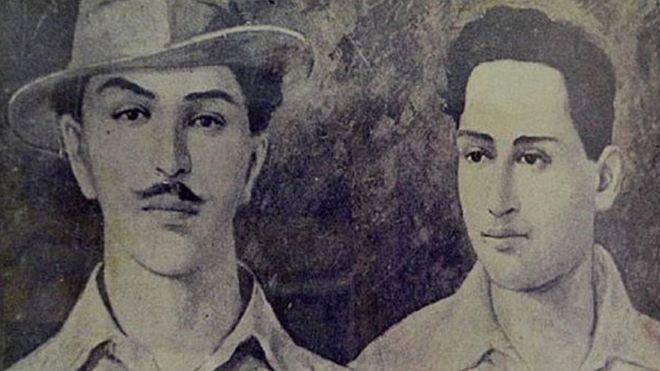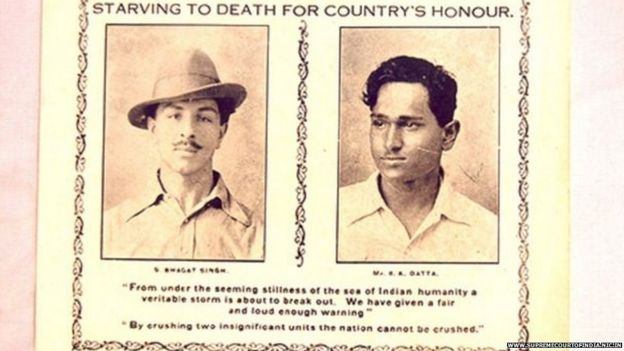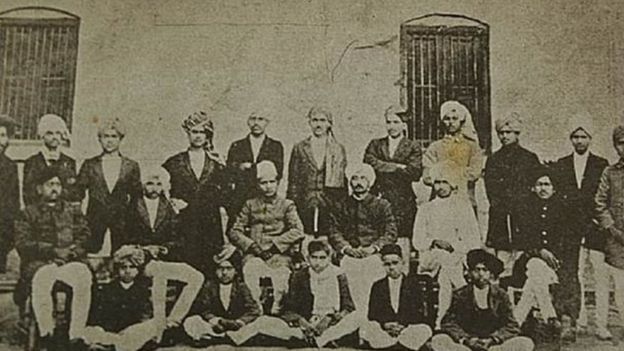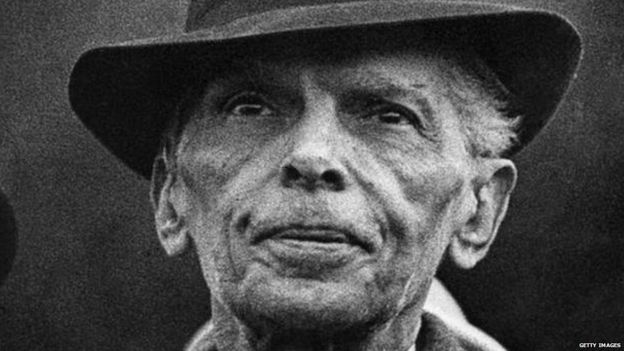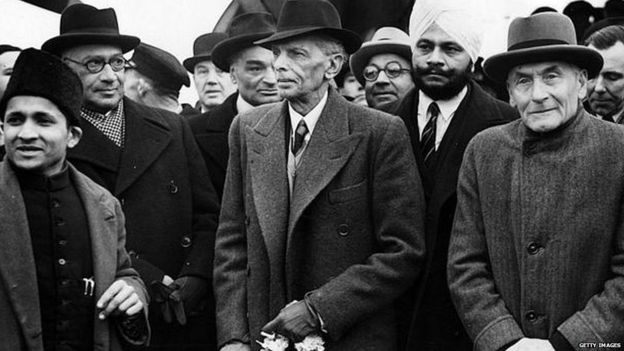Whose Bhagat
Singh is he anyway?
CHAMAN
LAL
RETIRED
PROFESSOR FROM JAWAHARLAL NEHRU UNIVERSITY
IS THE
AUTHOR OF UNDERSTANDING BHAGAT SINGH
12th August
Blink of Business Line(The Hindu)
Both the right-wing and Sikh
extremists are attempting to appropriate the legacy of the revolutionary who
stood for everything that is antithetical to their beliefs
Revolution’s poster
boy Like Che Guevara, Bhagat Singh’s appeal as an icon for the young has only
grown more than 80 years after his death v sreenivasa murthy
A few leaders across the world remain
in public imagination long after they are gone; but the narratives around them
continuously alter. Some become national or cultural symbols. William
Shakespeare, Leo Tolstoy and Rabindranath Tagore became icons of universal
literary and cultural values. Ho Chi Minh, Nelson Mandela and Mahatma Gandhi
were symbols of anti-colonial struggles. Simón Bolivar and José Marti, icons of
Latin American nationalism. Che Guevara, Fidel Castro and Hugo Chavez — torch-bearers
of revolution in Latin America. Bhagat Singh and Guevara continue to be youth
icons world over though they each earned their name in two different corners of
it.
Bhagat Singh died young — at 23, but
had already earned fame in that short lifespan. In the last two years of his
life — from April 1929 to March 1931 — he was extremely popular in the then
undivided India, which included today’s Pakistan, Bangladesh and Myanmar. Born
on September 28, 1907 at Lyallpur Bange, now in the Faisalabad district of
Pakistan, he made his mark in public life at 17 when he formed the Naujawan
Bharat Sabha in Lahore along with friends. He had always been politically
active, as had been his family. His father, Kishan Singh, and uncles — Ajit
Singh and Swaran Singh — were part of the Congress party as well as the freedom
struggle. The three of them went to jail many times, Swaran Singh died young,
at 23, after he contracted TB in prison. Ajit Singh was a close associate of
Lala Lajpat Rai and was sent to Mandalay jail in Burma in 1907 for organising
peasants — victims of debt then, as they are now. Ajit Singh was later exiled
to Latin America for 38 long years — till March 1947, when Jawaharlal Nehru, as
the interim Prime Minister, facilitated his return.
Bhagat Singh and his comrades such as
Chandra Shekhar Azad were disillusioned with the Congress after Gandhi withdrew
his massive Satyagraha — non-cooperation movement — in 1922 following the
burning of a police station in Chauri Chaura in Gorakhpur. Bhagat Singh, hardly
15 then, had wholeheartedly participated in the movement, and even suffered 30
lashes on his back for it. Legend has it that he shouted “Mahatma Gandhi ki
Jai!” after each lashing.
The movement’s withdrawal convinced
Bhagat Singh and Azad that the Congress was incapable of fighting British
colonialism. Only a revolutionary movement, they believed, could overthrow the
British. In 1922, Bhagat Singh joined Lahore’s National College, where he met
like-minded men like Bhagwati Charan Vohra, Sukhdev, Yashpal, Jaidev and Ram
Chandra. Some of their teachers such as Chhabil Das and Jaichander Vidyalankar
were linked to revolutionaries across the country. At the college’s Dwarkadas
library, Bhagat Singh read about the Soviet socialist revolution led by Lenin
in 1917. He directed and acted in many nationalistic plays, one of which was
watched by Sarojini Naidu.
The Naujawan Bharat Sabha was
modelled on Mazzini’s ‘Young Italy’ and Bhagat Singh was elected its general
secretary. He went to Kanpur with the names provided by his History teacher
Vidyalankar and met revolutionary leaders such as Shiv Verma, Jaidev Kapoor and
Bejoy Kumar Sinha. Following the efforts of Sachindra Nath Sanyal,
revolutionary groups such as Jugantar and Anushilan had merged to form the new
Hindustan Republican Association/Army (HRA). In Kanpur, Bhagat Singh worked as
a journalist in the Hindi paper Pratap , edited by Ganesh
Shankar Vidyarthi, and wrote under the pseudonym Balwant Singh. Bhagat Singh
was later associated with Maharathi and Arjun —
both Hindi journals from Delhi, and also Kirti in Punjabi, and
assumed different pseudonyms in each.
The first and most objective
narrative of Bhagat Singh’s life emerged from his early life — of a young mind
in quest of knowledge and freedom. Interestingly, in the latest narratives
around him, Bhagat Singh is acknowledged as a well-read thinker-revolutionary
with a socialist vision for post-liberation India. This objective image of
Bhagat Singh has, and still is distorted wittingly or unwittingly. Alarmingly,
of late it is being done consciously to undermine his ideological beliefs,
which come through clearly in his writings. His complete works, which
include Jail Notebook, letters and essays in Hindi, Punjabi,
Urdu and English, have been published in multiple Indian languages. Hence, he
has become a difficult subject to appropriate. Nevertheless, attempts are being
made both by the right-wing and some Sikh extremists to do so.
Even after becoming a part of the
HRA, Bhagat Singh and his comrades continued working for Naujawan Bharat Sabha
and Punjab Students Union. The HRA carried out the Kakori Rail dacoity in
August 1925 and subsequently lost Ram Prasad Bismil, Ashfaquallah, Roshan Singh
and Rajender Lahiri. By the end of 1927 all four were executed.
Bhagat Singh convinced the remaining
HRA members to abandon terrorist violence. He was inspired by the socialist
revolution in the Soviet Union and wanted to adopt its path for Indian
liberation. The HRA subsequently held a meeting at Delhi’s Feroz Shah Kotla grounds
in September 1928 and rechristened itself as the Hindustan Socialist Republican
Association/Army (HSRA). While the armed wing, helmed by Azad, was kept alive,
the focus shifted to political propaganda — liberating India from colonialism
and capitalist exploitation, and building a socialist society.
Politics and freedom
However, before the HSRA could
actively pursue the political path, the Simon Commission arrived, and Bhagat
Singh and friends convinced Lala Lajpat Rai to lead a mass procession against the
commission in Lahore, even though they were critical of Rai leaning towards
politics tinged with religion.
The procession was brutally
lathi-charged by the Lahore police led by SSP James Scott and DSP JP Saunders,
and it soon resulted in the death of Rai. A call to avenge Rai’s death was made
by Basanti Devi, widow of Chittaranjan Dass, the radical Congress leader from
Bengal, following which Bhagat Singh and comrades assassinated Saunders,
exactly a month after Rai’s death.
The young men knew they were running
out of time. In April 1929, Bhagat Singh and Batukeshwar Dutt hurled bombs in
the Central assembly, Delhi, to protest against two anti-people bills — the
Trade Disputes Bill and the Public Safety Bill — pushed through by the British
government as ordinances. Bhagat Singh had by then familiarised himself with
Auguste Vaillant, the French revolutionary who had lobbed a bomb in the French
parliament in 1893. He was executed a year later. Vaillant intended “not to
kill or harm”, but “to make the deaf hear.” Bhagat Singh was inspired by
Vaillant and their later lives bear striking similarities. Both remained avid
learners in their final days in prison; Bhagat Singh was found reading moments
before his execution, as was Vaillant; both refused to cover their faces at the
gallows, and are considered to have shown exemplary courage at the moment of
death — going to the gallows singing. Both remained atheists till the end —
refusing religious rites before the rope fell around their necks.
It was only after the Delhi assembly
incident that the police discovered Bhagat Singh’s involvement in Saunders’s
assassination. A month after the Delhi trial concluded in June 1929, the Lahore
conspiracy trial began. He was awarded the ‘transportation for life’ sentence
in the first, and death for the second in October 1930. The trials altered the
public perception of Bhagat Singh and his friends. They challenged the
authority of colonial courts, they shouted slogans, sang patriotic songs, and
were beaten up publicly. They went on a hunger strike in prison for 150 days.
All this made news nationally and internationally. By the time Bhagat Singh was
executed on March 23, 1931, along with Rajguru and Sukhdev, he was no longer
just a name. Gandhi was damned for “not saving Bhagat Singh’s life!” Gandhi and
the Congress party, while critical of their action, praised their bravery, thus
setting the foundation for an immortal, nevertheless incomplete image of
Shaheed-e-Azam Bhagat Singh. Credit must go to Periyar, the Tamil politician
and social activist, for giving Bhagat Singh a realistic portrayal in his
editorial in the weekly Kudai Arsu. He also published Bhagat
Singh’s essay ‘Why I am an Atheist’ in Tamil. When professor Bipan Chandra
wrote an introduction to the essay in the late 1970s, he called Bhagat Singh “a
Marxist in the making.” The publication of Bhagat Singh’s major works,
including theJail Notebook , in 1994 only enhanced this identity
and further nuanced into that of a “Marxist socialist revolutionary.” This
identity is now contested by the right-wing, which wants him to be nothing more
than the “nationalist revolutionary.” Constricting him thus is an insult to
Bhagat Singh’s larger worldview and influence. He is a popular icon in
neighbouring Pakistan, as well as in other countries.
The shape-shifting narratives around
Bhagat Singh is evident in his visual represention too. Till the 1980s, the
widely-circulated image of the revolutionary was a photograph, taken in a Delhi
studio in 1929, in which he wears a hat. However, with the rise of identity
politics in Punjab and elsewhere, his “hat-wearing image” has been gradually
replaced by a painting in which he sports a turban. That image, the product of
an artist’s imagination, has attained so much traction and heft that a turbaned
statue has replaced a hat-wearing one in Bhagat Singh’s ancestral village,
Banga. Recently, in Chhattisgarh, his hat-wearing statue was pulled down by
Sikh religious groups. The fact that he was an atheist is obviously lost on
them.
Bhagat Singh has become a
hotly-contested political subject lately. In 2009, both the Punjab and Haryana
governments had urged the centre to rename the Chandigarh airport after him.
But the Rashtriya Swayamsevak Sangh (RSS) wanted to name it after their
little-known leader Mangal Sen, and then chose to go silent on the matter.
While momentum gathers on naming the Gorakhpur airport after Yogi Gorakhnath,
and the Agra airport after Deendayal Upadhyaya, none in the right-wing wants
Bhagat Singh’s name for an airport or a university. However, no attempts to
appropriate him are spared.
chaman lal, retired professor from
Jawaharlal Nehru University, is the author ofUnderstanding Bhagat Singh
Changing Narratives on Bhagat
Singh
Chaman Lal*
There are few heroes in the world, who
remain in public imagination for very long time, though their narratives keep
changing. In few cases these heroes become icons and symbols as well, of
certain nationality or culture. Shakespeare (England), Tolstoy (Russia) or Tagore
(India) become icons of universal literary or cultural values. Ho Chi Minh
(Vietnam), Nelson Mandela (South Africa) or Mahatma Gandhi (South Asia) became
symbols of anti-colonial liberation struggles worldwide. Bolivar or Jose Marti
become icons of Latin American nationalism. Che Guevara, Fidel Castro or Chavez
become icons of modern revolution in Latin America. Bhagat Singh and Che
Guevara both have become icons of world youth too, though both earned their
name in history in two extremely different corners of the world. One in South
America and other in South Asia.
Bhagat Singh died young at the age of 23+
years, but he earned fame during his life time as well. In the last two years
of his life from April 1929 to 23rd March 1931, he was extremely
popular among undivided Indian people, which included today’s Pakistan,
Bangladesh and Myanmar. Born on 28th September 1907 at Chak no 105,
Lyallpur Bange, now in Pakistan known as Faisalabad district, he made his mark
in public life at quite young age of 17 years, when he formed Naujwan Bharat
Sabha in Lahore along with his friends and comrades. Prior to that also, he had
started participating in political life of the country. His family, including
his father Kishan Singh and two uncles-Ajit Singh and Swaran Singh were part of
Congress party and movement for freedom struggle. All three were going to jail
ample times, Swaran Singh died young at the age 23 years after he contacted TB
in jail, Ajit Singh was close associate of Lala Lajpat Rai and was sent to
Mandalay jail in Burma in 1907 for organising peasants, who were victims of
indebtedness as they are today. Later Ajit Singh remained exiled in Latin
America for 38 long years till March 1947, when Jawaharlal Nehru as interim
Prime Minister facilitated his return to India. Bhagat Singh, as his other
comrades like Chandershekhar Azad got disillusioned from Congress party as
Mahatma Gandhi withdrew his massive Satyagraha-non-cooperation movement in
1922, due to burning of a police station in Chauri Chaura in Gorakhpur district
of UP. Bhagat Singh was not even fifteen years then and Azad was just fifteen
plus, who participated in that movement and suffered thirty lashes on his back
by shouting on every lash-‘Mahatma Gandhi ki Jai’! So these young people
thought Congress party is not capable of fighting British colonialism, they
need to organise revolutionary movement to overthrow British colonial regime.
In 1922, Bhagat Singh joined National College Lahore, where he did his F.A. in
1923 and was further enrolled for B.A. in 1923. There were his other college
friends-Bhagwati Charan Vohra, Sukhdev, Yashpal, Jaidev, Ram Chandra etc. They
had nationalists and revolutionary teachers like Principal Chhabil Das,
Jaichander Vidyalankar etc. who had contacts with revolutionaries in other
parts of the country. National college Lahore had Dwarkadas library, which was
getting latest books from world over, including books on Soviet Socialist
revolution led by Lenin in 1917. Bhagat Singh was as much a voracious reader of
these books, as some of his teachers were, even at such young age of 16-17
years. He had creative skills as well, as he acted and directed many
nationalistic plays during his college days, one of which was watched even by
Sarojini Naidu then. Organising Naujwan Bharat Sabha on the pattern of ‘Young
Italy’ of Mazzini and Gary Baldy was his first socio-political activity. As per
Comrade Ram Chandra, he was elected President, Bhagat Singh as General
Secretary and Bhagwati Charan Vohra as Propaganda secretary of the Sabha.
Bhagat Singh went to Kanpur with contacts from his History teacher Jaichander
Vidyalankar and met revolutionary group there, which included Shiv Verma,
Jaidev Kapoor, Bejoy Kumar Sinha etc. With the efforts of Sachindernath Sanyal
many revolutionary groups of the country like Jugantar and Anushilan merged to
form new all India party named as ‘Hindustan Republican Association/Army’
(HRA). In Kanpur Bhagat Singh worked as journalist in Ganesh Shankar Vidyarthi
edited Hindi paper-‘Pratap’, where he wrote in the pen name of ‘Balwant Singh’.
Bhagat Singh later remained associated with papers like ‘Maharathi’ and
‘Arjun’-both Hindi journalsfrom Delhi and ‘Kirti’-Punjabi and Urdu from
Amritsar and Meerut, in all these papers he wrote under different pseudo names.
So the first and most objective narrative
of Bhagat Singh’s life emerged from his early life-an energetic young mind with
quest for knowledge and liberation with creative mind. (Photographs attached)
Interestingly the latest narrative of Bhagat Singh is acknowledged again as a
most well-read Thinker Revolutionary with Socialist vision for post liberation
India!
This foremost and objective
image of Bhagat Singh had been and still being distorted wittingly or
unwittingly, but lately mostly wittingly by a planned conspiracy to overshadow
his ideological orientation which is so obvious and clear from his writings,
which are being published in collections in various languages. By now his
complete writings (120+--letters, statements, Jail Notebook and essays in four
languages-Hindi, Punjabi, Urdu and English)) have been published in Hindi,
Marathi and Urdu languages and large number of writings have been published in
Punjabi, English, Tamil, Telugu, Kannada, Malayalam and Bengali, while few of
his writings have been published in Sindhi, Odia, Assamese, Manipuri and
Gujarati as well. So it has become difficult to appropriate him in superimposed
images of political vested interests, like RSS and some Sikh extremists tried
to do.
After becoming part of Hindustan Republican
Association/Army (HRA), along with Chandershekhar Azad, Ram Prasad Bismil,
Ashfaquallah and others at all India level, Bhagat Singh and his comrades in
Lahore continued with mass activities from Naujwan Bharat Sabha and Punjab
Students Union. He was an avid student of history and was learning its lessons
fast. HRA conducted Kakori Rail dacoity in August 1925 and lost its major
leaders like Ram Prasad Bismil, Ashfaquallah, Roshan Singh and Rajender Lahiri
by the end of 1927, when all four were executed.
From
National College Lahore Drama club group photo
 National College Lahore group photo.BS fourth from left standing
with white turban
National College Lahore group photo.BS fourth from left standing
with white turban
Bhagat Singh convinced remaining
comrades of HRA to leave the path of dacoities and have a new vision of Indian
liberation inspired by Socialist revolution in Soviet Union led by Lenin. So
HRA comrades held meeting in Ferozeshah Kotla grounds of Delhi on 8&9th
September 1928 and converted it in Hindustan Socialist Republican Association/Army
(HSRA), while keeping its armed wing alive under the commandership of
Chandershekhar Azad, it focus shifted to political propaganda for liberating
India from the yoke of colonialism and capitalist exploitation and building
Socialist India free of exploitation through mass uprisings of peasants and
workers. However before they could actively take to their changed political
path, Simon Commission came to India in October 1928 and Bhagat Singh and his
comrades convinced Lala Lajpat Rai, the tallest political leader of Punjab to
lead mass procession against Simon Commission in Lahore, despite their
criticism of late communal orientation of Lala Lajpat Rai. Procession was
brutally lathi charged on 30th October 1928 by Lahore police led by
SSP Lahore James Scott and DSP J P Saunders, resulting in the death of Lala
Lajpat Rai on 17th November 1928. At the resounding call of avenging
Lala Lajpat Rai’s death by Basanti Devi, widow of late Chittranjan Dass, the
most radical congress leader of Bengal, Bhagat Singh and Comrades, departing
from their new perspectives, assassinated J P Saunders, exactly a month after
on 17th December 1928. Bhagat Singh was part of this action and now
time was short for these revolutionaries to act. And the second biggest action
of these young thinker revolutionaries-Bhagat Singh and Batukeshwar Dutt was to
throw a harmless bomb in Central Assembly Delhi on 8th April 1929 to
protest against two anti-people bills pushed throgh by ordinances by British
colonial government. These bills were Trade Disputes Bill-an anti-working class
law and Public Safety Bill-an act to supress civil liberties. This action was
more in line with their new perspective as the action was ‘not to kill or
harm’, but ‘To Make the Deaf hear’, a phrase taken from French revolutionary
Valliant, who had thrown bomb in French Parliament in similar circumstances in
December 1893 and was executed in 1894. Bhagat Singh was inspired by Valliant’s
similar action earlier and both had lot of similarities in post action life as
well. Both kept on studying till the last moment in prison, Bhagat Singh was
reading a book on life of Lenin till last, so was Valliant reading some other
book, both had refused to wear black mask on faces at the time of going to
gallows and made a show of exemplary bravery by going to gallows singing. Both
asserted their atheism on gallows as well, refusing to partake any religious
rites before kissing the rope.
It was only after Delhi Assembly bomb
action, police found out Bhagat Singh’s involvement in Saunders assassination
and after the conclusion of Delhi trial in June 1929, Lahore conspiracy trial
began in July 1929. First resulted in ‘Transportation for Life’ on 12th
June 1929 and second in death sentence on 7th October 1930. It was
the period of both trials that Bhagat Singh image was raised to skies by his
and his comrades exemplary brave conduct in courts by challenging the authority
of colonial courts by shouting slogans and singing patriotic songs, getting
beaten up publically and observing 150 days hunger strike in jail, highlighted
by national and international media on front pages and by the time Bhagat Singh
was executed along with Rajguru and Sukhdev on 23rd March 1931, he
no longer remained a name, he turned into an immortal icon of bravery and
intelligence. Mahatma Gandhi the foremost symbol of India’s freedom struggle
got damned for ‘not saving Bhagat Singh’s life’! And it was Mahatma Gandhi and
Congress party, while criticising their actions, underlined the exemplary
bravery of these patriots, creating an immortal but incomplete image of supreme
martyr-Shaheed-e-Azam Bhagat Singh, which continued and continues most popular
narrative in Indian society. It goes to the credit of Periyar in Tamilnadu, who
projected correct image of Bhagat Singh in his editorial in Kudai Arsu issue of
29th March 1931 and got Bhagat Singh’s essay ‘Why I am an Atheist’
translated and published in Tamil by 1934. Further It was Prof. Bipan Chandra,
who in 1978 or so, completed this bravery image by adding to his socialist
visionary thinker revolutionary by reproducing his immortal ideological
essay-‘Why I am an Atheist’ with his introduction and underlining his
personality to be of ‘A Marxist in the making’! By the publication of Bhagat
Singh’s major writings, including his Jail Notebook in 1994, his ‘Marxist in
the Making’ image got further enhanced to ‘Marxist Socialist Revolutionary of
India’ image! This image is being contested by some right winger politicians,
trying to confine his image to just ‘nationalist revolutionary’, which is
complete distortion and insult to Bhagat Singh’s much larger world image, now
popular even in Pakistan and many other countries like Che Guevera!
Changing narrative on Bhagat Singh can
be seen from his changing photo images as well. Till almost 1980, the
predominant actual photo image of Bhagat Singh was of his last photograph taken
in Delhi studio in early April 1929, just before assembly bomb action. However
with the rise of identity politics, in Punjab and at many other places, his
‘hat wearing image’ was replaced by a painting based photograph of ‘turban
wearing image’, which was and is not his real photo image, it is imaginary
picture by a painter. It affected politico-social life so much that in Bhagat
Singh’s ancestral place in Banga, his hat wearing statue, inaugurated once by
thn Chief Minister Giani Zail Singh in 1974 or so, was taken off and was
replaced by ‘turban wearing statue’! In Raipur-Chhattisgarh recently, Bhagat
Singh’s hat wearing statue was even smashed by some Sikh religious bodies,
without realising as no one among religious fundamentalists reads Bhagat
Singh’s writings, that he was an atheist!
Bhagat Singh narratives have become
highly politicised lately, his writings and ideas based images and narratives
are being tried to be superimposed on his real, objective and ideas based
images and narratives, as RSS does with all history, but how long? Bhagat Singh
is like a burning fire, even in his iconic existence, he does not allow
rightist fascists to even touch him and exposes their duplicity and hypocrisy
in no time, as it happened in matter of naming Chandigarh airport on his name.
Both Punjab and Haryana Governments in 2009 had unanimously urged Central
Government to name Chandigarh airport as Shaheed Bhagat Singh international
airport, however while name chanting RSS tried to name it on little known RSS
leader Mangal Sen first and then adopted a conspiratorial silence on the issue.
While Yogi Aditynath is bent upon getting Gorakhpur airport named on Yogi
Gorakhnath and Agra airport on Deendyal Upadhyaya’s names and Moghul Sarai
railway station as Deen Dyal station, cat is out of bag on Bhagat Singh, none
in RSS wants his name to be perpetuated by naming Chandigarh airport on his
name or naming any University on his name, though keeping name chanting on!
***********
Painting based popular image of Bhagat
Singh
BS@11
Last
photograph of BS in April 1929
Only four
real pictures
*Chaman
Lal is retired Professor from JNU, New Delhi and editor of Bhagat Singh’s
writings. He is known for his book-Understanding Bhagat Singh.
H. no.
2690, Urban Estate phase-2, Patiala(Punjab)-147002












